Does Science Say We’re Alone in the Universe?
In last week’s blog I answered the question, Are we alone? from a biblical perspective. By “alone” I mean that humans are the only physical, intelligent species manifesting advanced civilization in the universe. Here, I will endeavor to answer the question from the perspective of biochemistry, observational astronomy, and cosmology.
Naturalistic Origin of Life?
During my days as an astronomy student, I took a short course from popular astronomer Carl Sagan, in which he laid out three fundamental requirements for a naturalistic origin of life: (1) a vast, concentrated soup of prebiotic molecules, (2) homochiral configuration (either 100 percent left-handed or 100 percent right-handed) of those prebiotic molecules, and (3) a very long duration of time. When students asked Sagan how vast and concentrated a soup was needed, he replied it would need to be something as large as all Earth’s oceans, where the oceans are maximally packed with homochiral prebiotic molecules. When we asked how much time, Sagan said at least a billion years.
In the decades that have passed since Sagan proposed his requirements, it has become clear that the time window for life’s origin on Earth is much briefer than a billion years. The Sun pelted Earth with deadly radiation until 4.0 billion years ago. Earth’s surface was episodically hellishly hot until 3.84 billion years ago. Stable liquid water oceans and stable rocks did not appear on Earth’s surface until 3.84–3.83 billion years ago. The earliest undisputed multiple isotope evidence for life on Earth dates at 3.825 ± 0.006 billion years ago.1 This measurement prompted evolutionary biologist Niles Eldredge to comment, “One of the most arresting facts that I have ever learned is that. . . . in the very oldest rocks that stand a chance of showing signs of life, we find those signs.”2
The moment physical and chemical conditions permit the existence of life on Earth, life appears, and not in just one form. The isotope evidence reveals a diversity of microbial species at the time of life’s origin on Earth.
Compounding the problem for abiogenesis (a naturalistic origin of life) is that there is also no prebiotic soup. Isotope ratios of carbonaceous molecules in Earth’s oldest rocks show evidence for postbiotics but no evidence of any prebiotics.3
A naturalistic origin of life crucially depends on the availability of a highly concentrated supply of prebiotics. At the time of life’s origin, prebiotics were neither abundant on Earth nor concentrated. In fact, they seem to have been nonexistent.
Yet another intractable dilemma for abiogenesis arises from the homochirality requirement. Amino acids cannot be linked together to make proteins unless all the amino acids have the same left-handed configuration. Neither can nucleosides be linked together to make DNA and RNA unless they are connected by ribose sugars all with the same right-handed configurations. Outside of organisms, amino acids and ribose exist in a racemic mixture, that is, random mixtures of left-handed and right-handed configurations. No natural source can be found, on Earth or anywhere else in the universe, for homochiral amino acids or sugars.4 Nor has research identified any possible natural source for the basic amino acids arginine, histidine, and lysine.5
There are many more intractable problems for abiogenesis.6 The three briefly described here—no time, no soup, no homochirality—are more than adequate to rule out this explanation for the origin of life. This closure establishes the Christian doctrine that life on Earth or anywhere else in the universe is possible only if God directly intervened to create that life.
Will Astrobiology Remain a Data-Free Scientific Discipline?
The Bible places few constraints on the possible existence of sites within the universe where ET (extraterrestrial) life and ETI (extraterrestrial intelligence) could possibly exist. Astrophysics, however, increasingly restricts possible extraterrestrial locations for ET life and ETI.
Astrobiology, the science of life beyond Earth, is the fastest-growing (in terms of funding) scientific discipline. Nevertheless, it is a data-free scientific discipline. What I mean by this description is that no evidence of physical life has been detected beyond Earth. The big question: will it remain a data-free discipline? The following five features of the universe constrain the parameters under which life can exist.
fine-tuned cosmic mass: The universe is extremely massive and extremely large. However, if the universe were even the tiniest bit less massive, the stars and planets that physical life requires would not exist, nor would the elements essential for life.7 The vast size of the universe is not a waste. It must be precisely the mass and extent that it is for even just one life-habitable planet to exist.
unique supergalaxy cluster: Supergalaxy clusters (clusters of clusters of galaxies) are the largest structures of ordinary matter in the universe. All but one supergalaxy cluster resembles the Shapley Supercluster (see figure 1) in that its galaxy clusters are jammed tightly together into a basketball- or football-shaped structure. The exception is the Laniakea Supercluster, which houses our Local Group of galaxies (see figure 2).
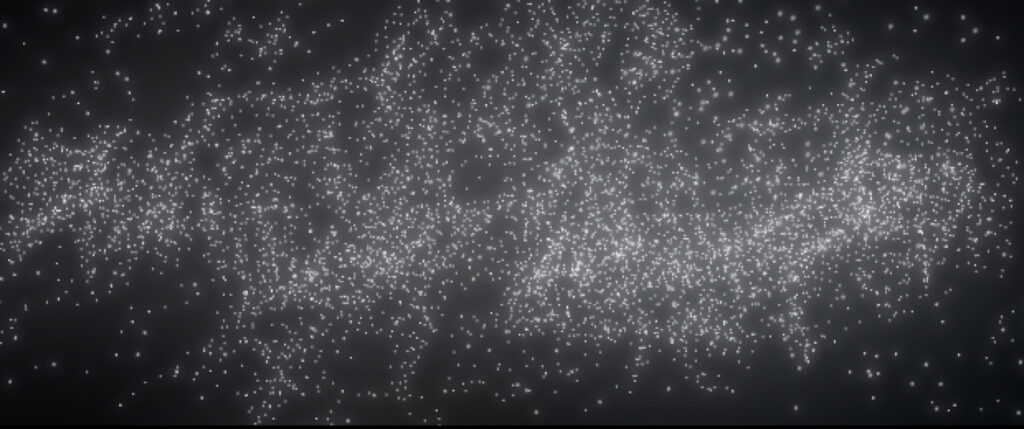
Figure 1: Shapley Supercluster
Each dot in this figure represents a grouping of galaxies. Credit: Andrew Z. Colvin, Creative Commons Attribution
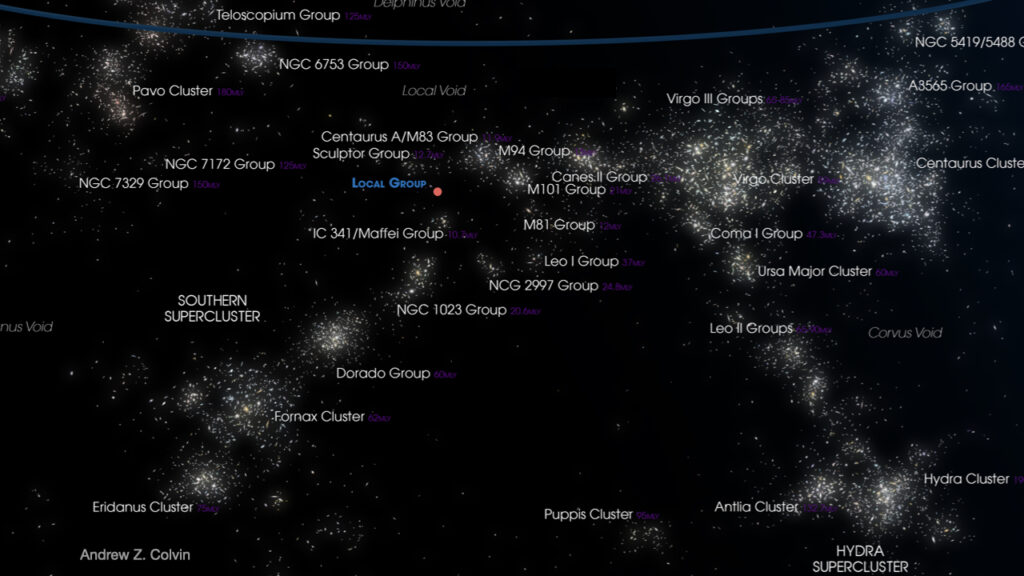
Figure 2: Laniakea Supercluster
The large dot (upper center) shows the location of the Local Group of galaxies, which is the home of the Milky Way Galaxy. Credit: Andrew Z. Colvin, Creative Commons Attribution
The Laniakea Supercluster is distinct from all other superclusters in that its galaxy clusters and galaxy groups are distributed along widely separated long filaments. Rather than resembling a sphere or an ellipsoid jam-packed with galaxy clusters and groups, the Laniakea Supercluster resembles a stick insect. This unique structure permits a large spiral galaxy to reside in a location where an adequate density of small dwarf galaxies exists to sustain—for several billion years—the galaxy’s spiral structure while ensuring the lack of nearby deadly supermassive black holes.
unique galaxy: For decades, astronomers have been observing galaxies nearby and galaxies far, far away in the quest to find a galaxy like the Milky Way Galaxy (MWG). Such a galaxy could be a candidate to harbor a planetary system where one of the system’s planets could conceivably support advanced life. This dedicated search has turned up a dozen large spiral galaxies that roughly resemble the MWG but lack its significant features needed for the support of advanced life. Those include the spiral arm structure and symmetry, the paucity of spurs and feathers between the spiral arms, the dark matter halo size, and central bar—to name just a few—that advanced life requires.8
Figure 3 shows the dozen known spiral galaxies that come the closest to matching the advanced-life critical features of the MWG. Figure 4 shows a detailed map of the MWG’s structure.
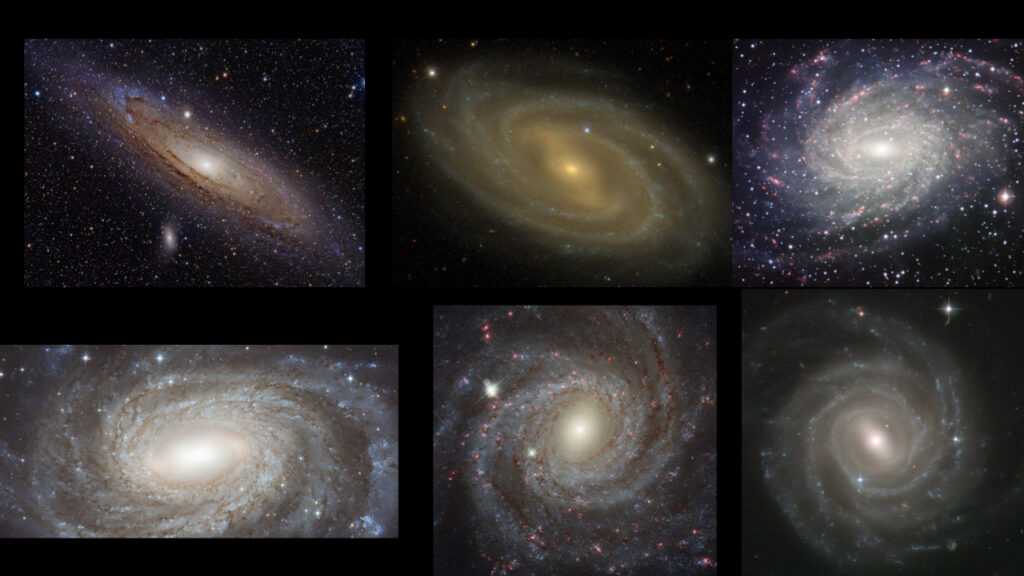
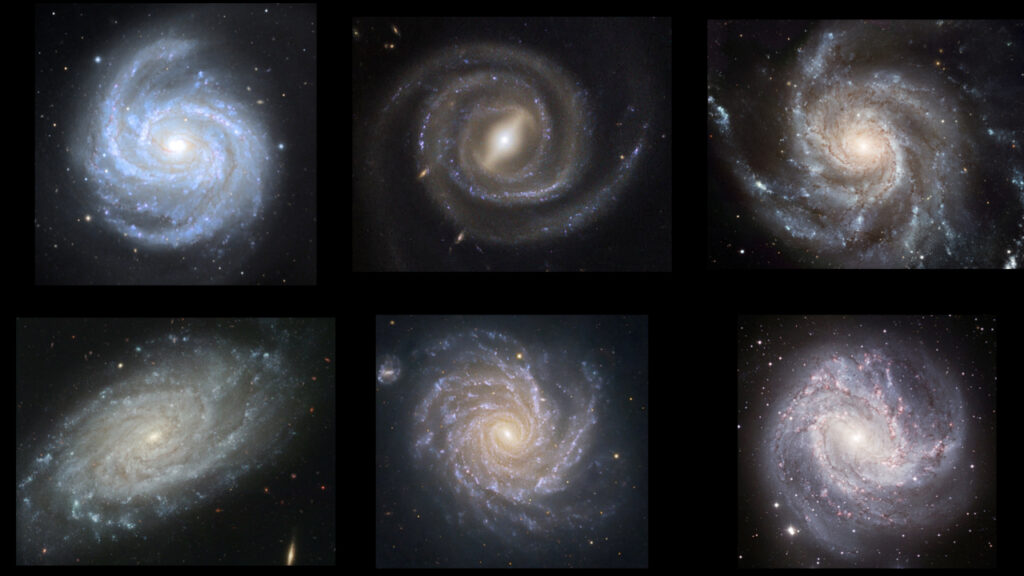
Figure 3: The Dozen Spiral Galaxies That Most Closely Match the Milky Way Galaxy’s Advanced-Life Critical Features
Credit: NASA/ESA/ESO
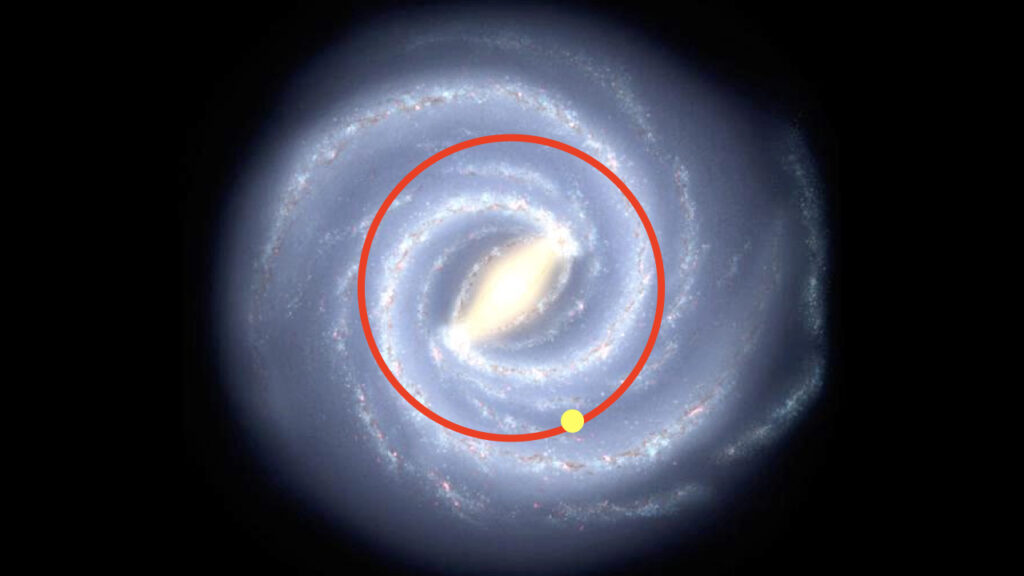
Figure 4: Detailed Map of the Milky Way Galaxy’s Structure
The large dot shows the location of the solar system. The annulus denotes the corotation distance. Credit: NASA/JPL-Caltech (R. Hurt)
Our MWG is the only known galaxy possessing all the galactic features that advanced life requires. This observation indicates that the MWG is likely the only galaxy in the Laniakea Supercluster where advanced life could possibly exist. Furthermore, there are only limited regions within the MWG where advanced life is possible.
unique star: For advanced life to be possible, its planet must reside in a safe zone between spiral arms for at least a hundred million years. This requirement implies that the planet’s planetary system orbit about the galactic center very close to, but not exactly at, the galaxy’s corotation distance.
The galactic corotation distance is the distance from the galactic center at which a star orbits about the galactic center at the same rate that the spiral arm structure rotates. At exactly this distance a planetary system will be subject to a mean motion resonance, which will result in the planetary system being ejected either inward or outward relative to the galactic center. At just inside the corotation distance, a stable orbit about the galactic center is possible where the planetary system crosses a spiral arm only about once every billion years. This orbital distance is known as the galactic habitable zone, the zone where life in the galaxy is possible.
The solar system orbit is just inside the corotation distance. Currently, the solar system is halfway between the Perseus and Sagittarius spiral arms. This location is the one region within the MWG where advanced life is possible and where it can safely reside for a substantial time period.
Our star, the Sun, is a middle-aged G2V hydrogen-fusing star. Only such stars manifest the luminosity stability and lack of flaring activity that the survival of advanced life needs.
For the past 60 years, astronomers have been scouring our galaxy’s habitable zone in search of a star other than the Sun that possesses the luminosity stability and lack of flaring activity to enable the existence of advanced life on one of its planets. A team of astronomers led by Timo Reinhold made detailed observations on 369 stars that most closely match the effective temperature, surface gravity, age, and metallicity (abundance of elements heavier than helium) of the Sun.9
Reinhold’s team determined that the average brightness variability for the 369 stars was 0.36%. This variability compares with 0.07% for the Sun’s median variability. That is, the brightness variability of stars that most closely match the Sun’s effective temperature, rotation period, metallicity, surface gravity, and age is five times higher than the Sun’s over the four-year period during which Reinhold’s team conducted their analysis.
Figure 5 shows (to scale) the Sun’s brightness variations compared to the solar-like star KIC7849521. KIC7849521’s brightness variations suitably represent the average variability of the sample of 369 stars.
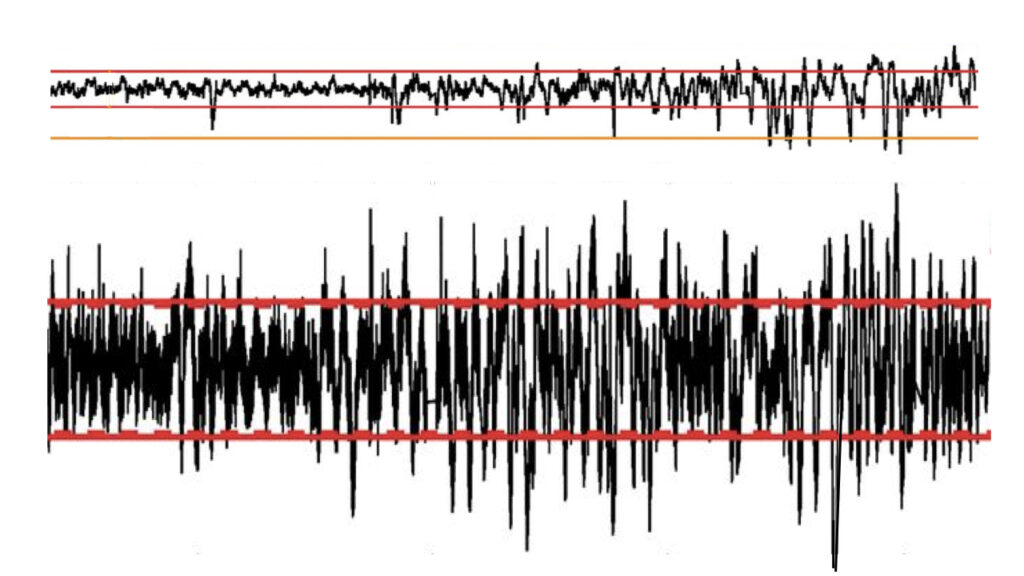
Figure 5: Brightness Variations for the Sun (top) and KIC7849521 (bottom) from March 2009 to April 2013
Adapted from figure 2, Timo Reinhold et al., “The Sun Is Less Active than Other Solar-Like Stars,” Science 368, no. 6490 (May 1, 2020): 519, doi:10.1126/science.aay3821.
Not only is the Sun exceptional in its luminosity stability, but also in manifesting an extremely low level of chromospheric/flaring activity.10 The past 9,000 years has been a period of truly remarkable solar luminosity stability and a period amazingly devoid of superflares. This combination and simultaneity of remarkable brightness stability and low flaring activity has made global high-technology civilization possible on Earth. Without extreme solar brightness stability, a lack of superflares, and a low rate of ordinary flares, there is no way that billions of humans could live and thrive on Earth at one time.
unique planet-moon system: Two recent studies now establish that advanced life is possible only on a planet-moon system that is identical to the Earth-Moon system in the following ways: (1) in its origin as the consequence of two planets merging together, (2) in the values and ratios of the masses and diameters of the planet and moon, (3) in the initial proximity of the planet and moon to one another, and (4) in the rate at which the planet and the moon separate from one another.11
There are many more features of the MWG, the Local Bubble, the Local Fluff, the Sun, the Sun’s planets and asteroid/comet belts, the Moon, and Earth that affirm this notion: Earth is likely the only body in the universe that is able to harbor an intelligent physical species capable of launching and sustaining high-technology global civilization.12 To word it another way, everywhere astronomers look beyond Earth they witness conditions that are hostile to advanced life and advanced civilization. Furthermore, as several astronomers have explained, the universe is too young to house more than one advanced species of physical life that has launched and sustained advanced civilization.13
From an astronomical perspective, we appear to be alone.
Check out more from Reasons to Believe @Reasons.org
Endnotes
- Craig E. Manning, Stephen J. Mojzsis, and T. Mark Harrison, “Geology, Age and Origin of Supracrustal Rocks at Akilia, West Greenland,” American Journal of Science 306, no. 5 (May 2006): 303–366, doi:10.2475/05.2006.02.
- Niles Eldredge, The Triumph of Evolution and the Failure of Creationism (New York: W. H. Freeman, 2000), 35–36.
- Manfred Schidlowski, “A 3,800-Million-Year Isotopic Record of Life from Carbon in Sedimentary Rocks,” Nature 333 (May 26, 1988): 313–318, doi:10.1038/333313a0; Minik T. Rosing, “13C-Depleted Carbon Microparticles in >3700-Ma Sea–Floor Sedimentary Rocks from West Greenland,” Science 283, no. 5402 (January 29, 1999): 674–676, doi:10.1126/science.283.5402.674; N. V. Grassineau et al., “Distinguishing Biological from Hydrothermal Signatures via Sulphur and Carbon Isotopes in Archaean Mineralizations at 3.8 and 2.7 Ga,” Geological Society London, Special Publications 248, no. 1 (2005): 195–212, doi:10.1144/GSL.SP.2005.248.01.11; Kevin D. McKeegan, Anatoliy B. Kudryavtsev, and J. William Schopf, “Raman and Ion Microscopic Imagery of Graphitic Inclusions in Apatite from Older than 3830 Ma Akilia Supracrustal Rocks, West Greenland,” Geology 35, no. 7 (July 2007): 591–594, doi:10.1130/G23465A.1.
- Richard N. Boyd et al., “Sites That Can Produce Left-Handed Amino Acids in the Supernova Neutrino Amino Acid Processing Model,” Astrophysical Journal 856, no. 1 (March 21, 2018): id. 26, doi:10.3847/1538-4357/aaad5f; Hugh Ross, “Natural Source of Life’s Homochiral Molecules?” Today’s New Reason to Believe (blog), Reasons to Believe, April 30, 2018; Fazale Rana and Hugh Ross, Origins of Life (Covina, CA: RTB Press, 2014), 125–136; Fazale Rana, “Explanation for Origin-of-Life’s Molecular Handedness Is Insoluble,” Reasons to Believe, May 8, 2008; Fazale Rana, “One More Crack in the Mirror: Misplaced Hope in the Latest Model for the Origin of Life,” Reasons to Believe, October 9, 2011; Hugh Ross, “Homochirality and the Origin of Life,” Reasons to Believe, November 7, 2011.
- Gene D. McDonald and Michael C. Storrie-Lombardi, “Biochemical Constraints in a Protobiotic Earth Devoid of Basic Amino Acids: The ‘BAA(-) World,’” Astrobiology 10, no. 10 (December 2010): 989–1000, doi:10.1089/ast.2010.0484; Hugh Ross, “Rare Amino Acid Challenge to the Origin of Life,” Reasons to Believe, April 11, 2011.
- Rana and Ross, Origins of Life.
- I explain the reasons why in Hugh Ross, Why the Universe Is the Way It Is (Grand Rapids, MI: Baker Books, 2008), chapter 2.
- Hugh Ross, Designed to the Core (Covina, CA: RTB Press, 2022), chapters 6–8.
- Timo Reinhold et al., “The Sun Is Less Active than Other Solar-Like Stars,” Science 368, no. 6490 (May 1, 2020): 518–521, doi:10.1126/science.aay3821.
- Jinghua Zhang et al., “Solar-Type Stars Observed by LAMOST and Kepler,” Astrophysical Journal Letters 894, no. 1 (May 4, 2020): id. L11, doi:10.3847/2041-8213/ab8795.
- James Green et al., “When the Moon Had a Magnetosphere,” Science Advances 6, no. 42 (October 14, 2020): eabc0865, doi:10.1126/sciadv.abc0865; John A. Tarduno et al., “Absence of a Long-Lived Lunar Paleomagnetosphere,” Science Advances 7, no. 32 (August 4, 2021), id. eabi7647, doi:10.1126/sciadv.abi7647; Hugh Ross, “Moon’s Early Magnetic Field Made Human Existence Possible,” Today’s New Reason to Believe (blog), Reasons to Believe, November 16, 2020; Hugh Ross, “Earth-Moon Coupled Magnetosphere Paved the Way for Life,” Today’s New Reason to Believe (blog), Reasons to Believe, September 20, 2021.
- Hugh Ross, Designed to the Core.
- Andrew E. Snyder-Beattie et al., “The Timing of Evolutionary Transitions Suggests Intelligent Life Is Rare,” Astrobiology 21, no. 3 (March 10, 2021): 265–278, doi:10.1089/ast.2019.2149; Anders Sandberg, Eric Drexler, and Toby Ord, “Dissolving the Fermi Paradox,” arXiv, physics, arXiv:1806.02404 (June 6, 2018), arxiv.org/abs/1806.02404.





